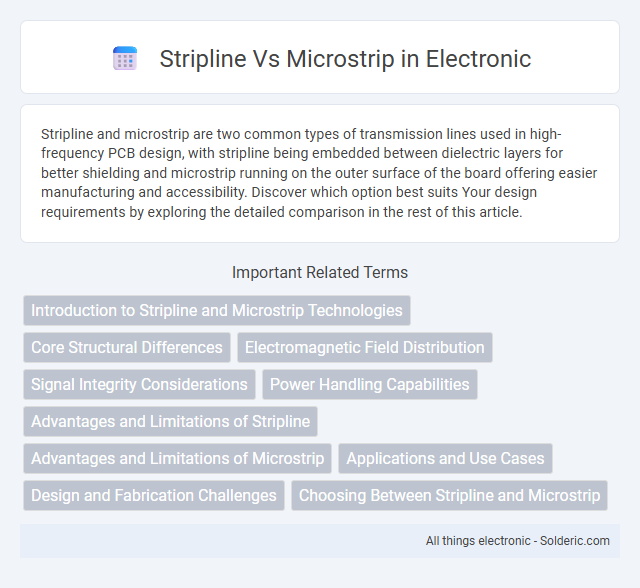Stripline and microstrip are two common types of transmission lines used in high-frequency PCB design, with stripline being embedded between dielectric layers for better shielding and microstrip running on the outer surface of the board offering easier manufacturing and accessibility. Discover which option best suits Your design requirements by exploring the detailed comparison in the rest of this article.
Comparison Table
| Feature | Stripline | Microstrip |
|---|---|---|
| Structure | Conductor sandwiched between two ground planes inside dielectric | Conductor on top of dielectric substrate with ground plane underneath |
| Signal Containment | Fully enclosed, better shielding | Partially exposed, less shielding |
| Characteristic Impedance | Controlled by dielectric thickness and width | Controlled by substrate height and width |
| Losses | Lower radiation loss, but higher dielectric loss | Higher radiation loss, lower dielectric loss |
| Operating Frequency | Suitable for high-frequency, microwave circuits | Common for microwave and RF applications |
| Manufacturing Complexity | More complex due to multi-layer construction | Simpler, single-layer fabrication |
| Height Profile | Lower profile, suitable for compact designs | Higher profile due to substrate thickness |
| Cost | Higher cost due to complex manufacturing | Lower cost, easier fabrication |
Introduction to Stripline and Microstrip Technologies
Stripline and microstrip technologies are fundamental transmission line structures used in high-frequency circuit design for signal routing and impedance control. Stripline consists of a conductor sandwiched between two ground planes, offering excellent shielding and reduced radiation loss, whereas microstrip features a conductor trace on a dielectric substrate with a single ground plane, providing easier fabrication and accessibility. Your choice between stripline and microstrip impacts signal integrity, electromagnetic interference, and overall performance in RF and microwave applications.
Core Structural Differences
Stripline consists of a signal conductor sandwiched between two parallel ground planes within a dielectric substrate, offering symmetrical electromagnetic fields and enhanced shielding. Microstrip features a signal conductor on the top surface of the dielectric substrate with a single ground plane beneath, resulting in asymmetrical field distribution and easier fabrication. The core structural difference lies in the stripline's embedded conductor versus the microstrip's surface conductor configuration, influencing signal integrity and electromagnetic interference characteristics.
Electromagnetic Field Distribution
Stripline offers a controlled electromagnetic field distribution by confining the fields between two ground planes, resulting in reduced radiation and minimal interference. Microstrip exhibits an open field distribution, with electromagnetic fields extending into the air above the dielectric substrate, which exposes your design to greater environmental noise and signal loss. Understanding these differences is crucial for choosing the appropriate transmission line structure to optimize signal integrity and performance in high-frequency circuits.
Signal Integrity Considerations
Stripline offers superior signal integrity due to its fully enclosed ground planes, which provide excellent electromagnetic shielding and reduce crosstalk and EMI. Microstrip, with one side exposed to air, experiences higher radiation losses and increased susceptibility to external noise, impacting high-frequency signal quality. The choice between stripline and microstrip affects impedance control and signal return paths, critical for minimizing signal distortion in high-speed PCB designs.
Power Handling Capabilities
Stripline offers superior power handling capabilities compared to microstrip due to its enclosed structure, which provides better thermal dissipation and reduced radiation losses. Microstrip lines tend to handle lower power levels as their exposed conductor is more susceptible to dielectric breakdown and environmental factors. For applications requiring high power transmission, your choice of stripline can ensure enhanced reliability and performance.
Advantages and Limitations of Stripline
Stripline offers superior electromagnetic shielding and reduced radiation loss compared to microstrip, making it ideal for high-frequency applications requiring signal integrity and minimal crosstalk. Its symmetrical structure provides consistent impedance and better noise immunity, but manufacturing complexity and difficulty in visual inspection are primary limitations. You should consider stripline when precise signal control and compact multilayer PCB designs are essential despite higher production costs.
Advantages and Limitations of Microstrip
Microstrip offers easy fabrication, low cost, and compatibility with surface-mount technology, making it ideal for compact RF circuits and printed circuit boards. Its open structure allows for straightforward inspection and modification but suffers from higher radiation loss and susceptibility to electromagnetic interference compared to stripline. You must consider microstrip's limited shielding and lower Q-factor when high isolation and performance precision are critical.
Applications and Use Cases
Stripline is ideal for high-frequency, low-radiation environments in aerospace and defense applications where signal integrity and electromagnetic interference suppression are critical. Microstrip is widely used in consumer electronics, wireless communication devices, and printed circuit boards due to its ease of manufacturing and cost-effectiveness. Your choice between stripline and microstrip depends on specific requirements such as signal shielding, frequency range, and space constraints in your application.
Design and Fabrication Challenges
Stripline design involves embedding the conductor between two ground planes, complicating fabrication due to the need for precise dielectric thickness control and multilayer alignment. Microstrip fabrication is simpler, using a single ground plane beneath the conductor, but faces challenges in managing environmental variations and maintaining consistent substrate properties. Both technologies require careful impedance control, though stripline offers better shielding while microstrip provides easier access for testing and modifications.
Choosing Between Stripline and Microstrip
Choosing between stripline and microstrip requires evaluating your circuit's electromagnetic performance and layout constraints. Stripline offers superior shielding and reduced crosstalk, making it ideal for high-frequency or sensitive signal applications, while microstrip provides easier access for testing and lower fabrication costs, often preferred for less critical signals. Your decision hinges on balancing performance demands with manufacturing complexity and cost considerations.
Stripline vs Microstrip Infographic

 solderic.com
solderic.com